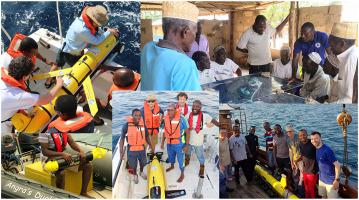Ocean & Coastal Management ( IF 4.6 ) Pub Date : 2021-07-20 , DOI: 10.1016/j.ocecoaman.2021.105805 Matthew R. Palmer 1 , Yohana W. Shagude 2 , Michael J. Roberts 1, 3 , Ekaterina Popova 1 , Juliane U. Wihsgott 1 , Shankar Aswani 4 , Jack Coupland 4 , John A. Howe 5 , Brian J. Bett 1 , Kennedy E. Osuka 6, 7 , Colin Abernethy 5 , Sofia Alexiou 1 , Stuart C. Painter 1 , Joseph N. Kamau 8 , Ntahondi Nyandwi 2 , Baraka Sekadende 9

|
Marine robots have the potential to enhance WIO marine research to improve regional adaptation to the challenges presented by climate change by providing enhanced research capacity that bypasses the requirement for expensive infrastructure, such as large research vessels. This paper tests this potential and assesses the readiness of WIO communities to adopt autonomous technologies to meet its marine research priorities.
We apply a range of analyses to a marine robots case study undertaken in waters around the island of Pemba, part of the Zanzibar archipelago, in Tanzania in 2019. The campaign formed part of a multinational project focused on increasing WIO capacity to meet food security and ocean sustainability challenges. A community engagement programme with six Tanzanian coastal communities resulted in positive changes in attitudes towards marine robots with reported increases in understanding and acceptance of such technologies. Suspicion of the robots was reduced and a lower risk of removing operational equipment was recorded following the provision of educational material. Cost, risk and benefit analysis shows that marine robots are perceived to provide high level benefits, but come at a high cost that is difficult to achieve using national or regional funding. An assessment of the capacity of WIO marine institutes to adopt such technologies shows that prior to this work, few skills or infrastructure related to marine robots were available to researchers and further confirmed that funding opportunities were perceived to be largely unavailable at institutional, national, regional or international levels. Responses from regional partners following completion of the case study however, revealed an uplift in perceived capacity, particularly related to access to infrastructure and expertise as well as support and opportunities for funding at each level. The presented case study is shown to have been a valuable demonstrator of the benefits of using marine robots to meet WIO coastal ocean research requirements and regional capacity was shown to be substantially increased within the broad range of marine institutes surveyed throughout the case study period.
This study demonstrates that taking early steps towards adopting marine autonomous robots has increased WIO regional marine research capacity and increased the confidence and willingness of local researchers to seek alternative solutions to ongoing marine research challenges. Recommendations for future action that will continue to increase the capacity and readiness for regional adoption of marine robots include investment at local, national and regional levels to provide accessible training opportunities and to facilitate regional and international collaborations; investment in a regional hub, or centre of excellence for marine robotic technology; early adoption of newly emerging smaller, cheaper autonomous technologies; investment in local skills and support facilities to aid local buy-in and acceptance while supporting regional capacity.
中文翻译:

用于西印度洋沿海海洋研究的海洋机器人
海洋机器人具有增强 WIO 海洋研究的潜力,通过提供增强的研究能力绕过对大型研究船等昂贵基础设施的需求,从而提高区域对气候变化挑战的适应能力。本文测试了这种潜力并评估了 WIO 社区采用自主技术以满足其海洋研究重点的准备情况。
我们对 2019 年在坦桑尼亚桑给巴尔群岛的一部分奔巴岛周围水域进行的海洋机器人案例研究进行了一系列分析。该活动是一个跨国项目的一部分,该项目的重点是提高 WIO 能力以满足粮食安全和海洋可持续性挑战。与六个坦桑尼亚沿海社区的社区参与计划导致对海洋机器人的态度发生积极变化,据报道对此类技术的理解和接受程度有所提高。在提供教育材料后,对机器人的怀疑减少了,移除操作设备的风险也降低了。成本、风险和收益分析表明,海洋机器人被认为提供高水平的收益,但代价高昂,使用国家或区域资金难以实现。对 WIO 海洋研究所采用此类技术的能力的评估表明,在开展这项工作之前,研究人员几乎无法获得与海洋机器人相关的技能或基础设施,并进一步证实,机构、国家和区域几乎无法获得资助机会。或国际水平。然而,在完成案例研究后,区域合作伙伴的回应显示,感知能力有所提升,尤其是在获得基础设施和专业知识以及各级资金支持和机会方面。
这项研究表明,在采用海洋自主机器人方面采取早期措施提高了 WIO 区域海洋研究能力,并增强了当地研究人员为当前海洋研究挑战寻求替代解决方案的信心和意愿。将继续提高区域采用海洋机器人的能力和准备情况的未来行动建议包括在地方、国家和区域层面进行投资,以提供无障碍培训机会并促进区域和国际合作;投资区域枢纽或海洋机器人技术卓越中心;尽早采用新兴的更小、更便宜的自主技术;投资当地技能和支持设施,以帮助当地接受和接受,同时支持区域能力。



























 京公网安备 11010802027423号
京公网安备 11010802027423号